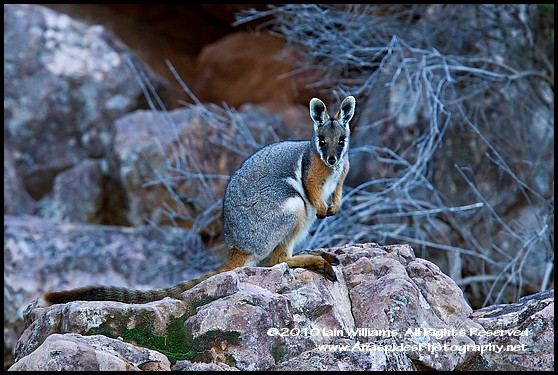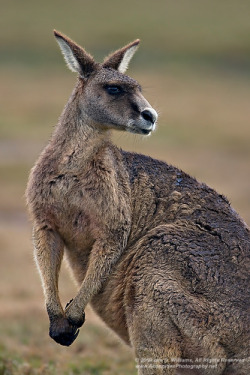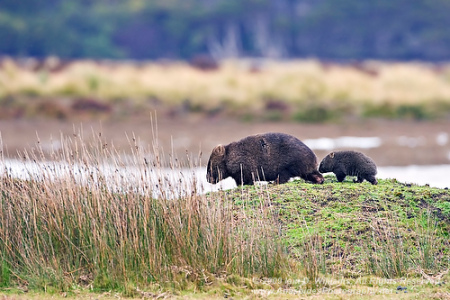Yellow-footed Rock Wallabies (Petrogale xanthopus) - South Australia
 Tuesday, July 6, 2010 at 11:00AM
Tuesday, July 6, 2010 at 11:00AM  A 600 km trip north of Kangaroo Island placed me at a favoured location to photograph Yellow-footed Rock Wallabies (Petrogale xanthopus). I’ve been coming to this location for several years and have been excited at watching the population of these threatened small marsupials slowing increasing in number.
A 600 km trip north of Kangaroo Island placed me at a favoured location to photograph Yellow-footed Rock Wallabies (Petrogale xanthopus). I’ve been coming to this location for several years and have been excited at watching the population of these threatened small marsupials slowing increasing in number.
LEFT: A Yellow Foot, it's spectacular and distinctive fluffed tail showing, sits on a rock in-between feeding.
Hunted by the early settlers for their ornate yellow brown coats, colonies were only observed in a few far flung regions of their former range; the wallabies almost became extinct. Although hunting has since been made illegal and few if any are actually shot by hunters today, the yellow foots are still in trouble. Clearing practices and the introduction of feral goats have destroyed much of their former habitat. Goats are particularly troublesome as they eat the vegetation favoured by the wallabies. Additionally, the goat’s hard hoofs (no native Australian animals has hard hoofs) destroys the soil structure which increases the likelihood of erosion. Australian authorities have instigated a campaign against the feral goats and regular aerial culling has reduced goat population numbers which has allowed the wallabies to expand their range to the point that the population is now slowly recovering.
The yellow foots live high on the scree slopes and sleep most of the day in rock overhangs and  caves, only migrating to the lower slopes in the late afternoon to spend the evening foraging on vegetation. In the morning they move upwards onto the scree slopes to avoid one of their natural predators, the Wedge-tailed Eagle.
caves, only migrating to the lower slopes in the late afternoon to spend the evening foraging on vegetation. In the morning they move upwards onto the scree slopes to avoid one of their natural predators, the Wedge-tailed Eagle.
LEFT: Yellow-footed Rock Wallabies enjoy sitting on rocks which  is their favoured habitat.
is their favoured habitat.
It rarely rains in the arid region, however, when it does the arid region is transformed form a dry arid desert environment to a lush green tapestry of vegetation. Rain had fell for almost a month before my visit and areas usually devoid of vegetation were carpeted in green. This increase in available vegetation meant that the wallabies did not have to move to the lower slopes to feed. Although the recent rain and increase in vegetation will no doubt allow the wallabies to breed thereby adding to the population, it did mean that photographic opportunities were somewhat less than optimal.
CHALLENGING ENVIRONMENT
Photographing in the wallaby area is very challenging for several reasons. Dust is a BIG issue and keeping sensors clean is almost impossible when changing lenses. Another challenge is the actual time that you have available to actually take photographs of the yellow foots. As mentioned, they live high on the scree slopes and venture down to lower elevation only in the late afternoon, leaving for the scree slopes in the early morning. The topography of this area is such that the sun drops behind the scree slope in the late afternoon leaving roughly 30-45 minutes in which you can capture the wallabies on "film" before the sun and light is gone. Likewise, in the morning you have about the same amount of time before the sunlight is too harsh (unless cloudy conditions prevail).
I was keen to shoot portraits, however, sneaking close enough to acquire a full frame portrait was next to impossible on this visit. There was just too much vegetation around for the wallabies to feed on and as such many of the individuals didn't approach close enough to my hide in the rocks. So rather than worry them by attemopting to get closer, I concentrated on aquiring several environmental shiots tht depeicted the animals (hopefully with tail) in its rocky environment.
No matter what the photographic result, it's always a pleasure to share some time with the yellow foots watching them as they bound along the rocks at almost supersonic speeds! This animal receives 10/10 for agility, flexibility and speed.
Search the archive for addtional Yellow-footed Rock Wallaby images & my blog post in 2009







